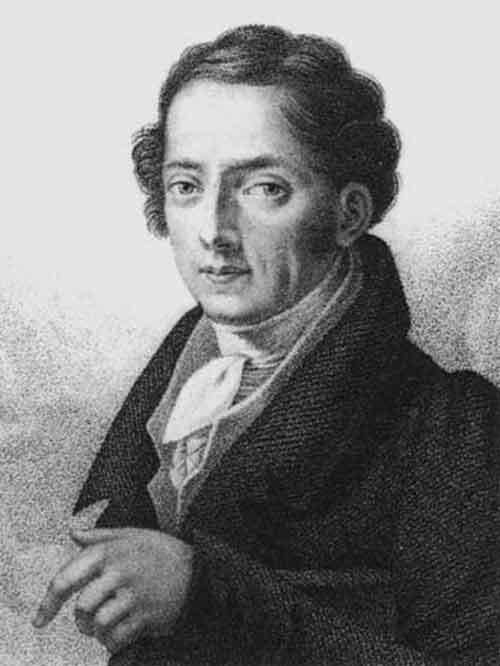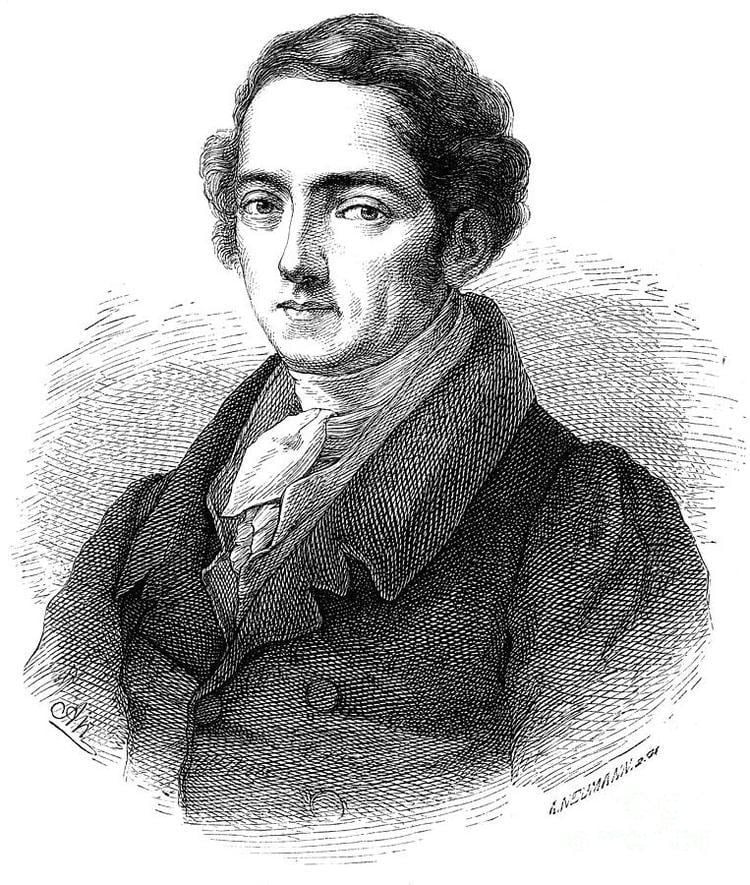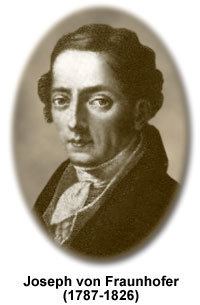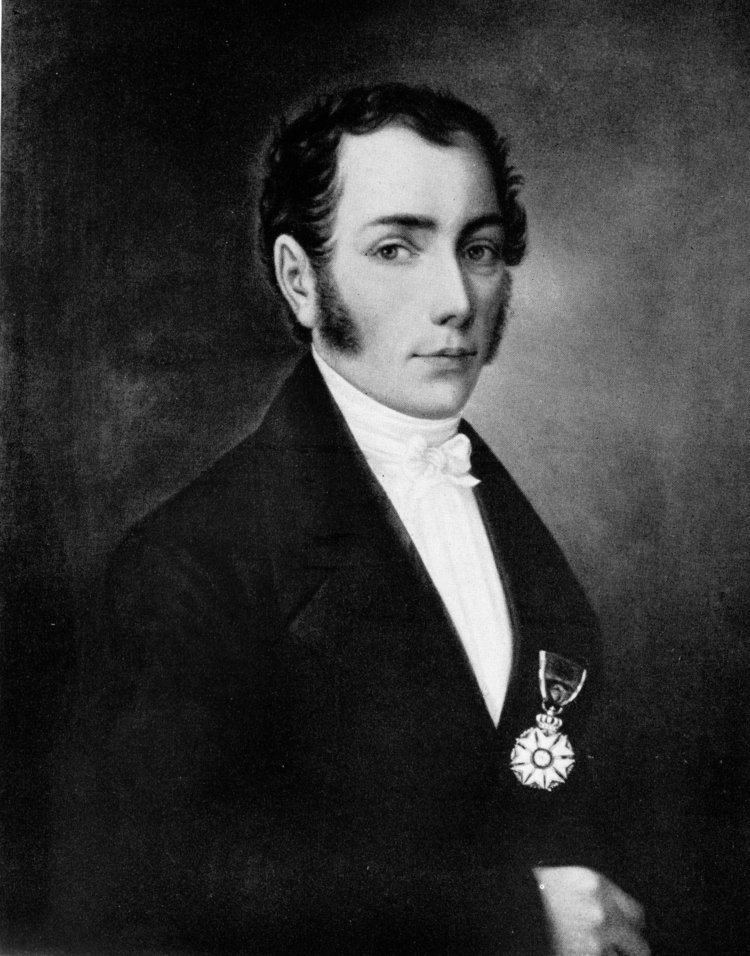Name Joseph Fraunhofer | ||
 | ||
Born 6 March 1787Straubing, Bavaria ( 1787-03-06 ) Similar People | ||
Wer war Joseph von Fraunhofer ?
Joseph Ritter von Fraunhofer (6 March 1787 – 7 June 1826) was a Bavarian physicist and optical lens manufacturer. He made optical glass and achromatic telescope objective lenses, invented the spectroscope and developed the diffraction grating. He discovered and studied the dark absorption lines in the spectrum of the sun now known as Fraunhofer lines.
Contents
- Wer war Joseph von Fraunhofer
- Joseph von fraunhofer 1787 1826
- Biography
- Invention and scientific research
- Telescopes and optical instruments
- Works
- References

Joseph von fraunhofer 1787 1826
Biography

Joseph Fraunhofer was born in Straubing, in the Electorate of Bavaria, to Franz Xaver Fraunhofer and Maria Anna Frohlich. He was orphaned at the age of 11, and started working as an apprentice to a harsh glassmaker named Philipp Anton Weichelsberger. In 1801, the workshop in which he was working collapsed and he was buried in the rubble. The rescue operation was led by Prince-Elector Maximilian Joseph. The prince entered Fraunhofer's life, providing him with books and forcing his employer to allow the young Fraunhofer time to study.

Joseph Utzschneider was also at the site of the disaster, a fact which turned out to be important. With the money given to him by the prince upon his rescue and the support he received from Utzschneider, Fraunhofer was able to continue his education alongside his practical training. In 1806, Utzschneider and Georg von Reichenbach brought Fraunhofer into their Institute at Benediktbeuern, a secularised Benedictine monastery devoted to glass making. There he discovered how to make the world's finest optical glass and invented incredibly precise methods for measuring dispersion.

It was at the Institute that Fraunhofer met Pierre Louis Guinand, a Swiss glass technician, whom Utzschneider had introduce Fraunhofer to the secrets of glass making. In 1809 the mechanical part of the Optical Institute was chiefly under Fraunhofer's direction, and that same year he became one of the members of the firm. In 1814, Guinand left the firm, as did Reichenbach, and Fraunhofer became a partner in the firm, the name being changed to Utzschneider und Fraunhofer. In 1818, he became the director of the Optical Institute. Due to the fine optical instruments he had developed, Bavaria overtook England as the centre of the optics industry. Even the likes of Michael Faraday were unable to produce glass that could rival Fraunhofer's.

His illustrious career eventually earned him an honorary doctorate from the University of Erlangen in 1822. In 1824, Fraunhofer was appointed an Knight of the Order of Merit of the Bavarian Crown by King Maximilian I, through which he was raised into the personal nobility (with the title "Ritter von", i.e. knight). The same year, he was also made an honorary citizen of Munich.

Like many glassmakers of his era who were poisoned by heavy metal vapours, Fraunhofer died young, in 1826 at the age of 39. His most valuable glassmaking recipes are thought to have gone to the grave with him.
Invention and scientific research
One of the most difficult operations of practical optics was to polish the spherical surfaces of large object glasses accurately. Fraunhofer invented a machine which rendered the surface more accurately than traditional grinding. He also invented other grinding and polishing machines, and introduced many improvements into the manufacture of the different kinds of glass used for optical instruments, and which he found to be always injured by flaws and irregularities of various sorts.
In 1811 he constructed a new kind of furnace, and on the second occasion when he melted a large quantity found that he could produce flint glass, which, taken from the bottom of a vessel containing two hundredweight of glass, had the same refractive power as glass taken from the surface. He found that the English crown glass and the German table glass both contained defects occasioning irregular refraction. In the thicker and larger glasses, there would be more of such defects, so that in larger telescopes this kind of glass would not be fit for object glasses. Fraunhofer therefore made his own crown glass.
The cause which had hitherto prevented the accurate determination of the power of a given medium to refract the rays of light and separate the different colors which they contain was chiefly the circumstance that the colors of the spectrum have no precise limits, and that the transition from one to another is gradual and not immediate; hence, the angle of refraction could not be accurately measured. To obviate this, Fraunhofer made a series of experiments for the purpose of producing homogeneous light artificially, and unable to effect his object in a direct way, he did so by means of lamps and prisms.
Thus in 1814, Fraunhofer invented the spectroscope. In the course of his experiments he discovered the bright fixed line which appears in the orange color of the spectrum when it is produced by the light of fire. This line enabled him afterward to determine the absolute power of refraction in different substances. Experiments to ascertain whether the solar spectrum contained the same bright line in the orange as that produced by the light of fire led him to the discovery of 574 dark fixed lines in the solar spectrum; millions of such fixed absorption lines are now known.
These dark fixed lines were later shown to be atomic absorption lines, as explained by Kirchhoff and Bunsen in 1859. These lines are still called Fraunhofer lines in his honor; his discovery had gone far beyond the half-dozen apparent divisions in the solar spectrum that had previously been noted by Wollaston in 1802.
Fraunhofer also developed a diffraction grating in 1821, which occurred after James Gregory discovered the principles of diffraction grating and after American astronomer David Rittenhouse invented the first man-made diffraction grating in 1785. Fraunhofer found out that the spectra of Sirius and other first-magnitude stars differed from the sun and from each other, thus founding stellar spectroscopy.
Ultimately, however, his primary passion was still practical optics, once noting that "In all my experiments I could, owing to lack of time, pay attention to only those matters which appeared to have a bearing upon practical optics".
Telescopes and optical instruments
Fraunhofer produced various optical instruments including microscopes for his firm. This included the Fraunhofer Dorpat Refractor used by Struve (delivered 1824 to Dorpat Observatory), and the Bessel Heliometer (delivered posthumously), which were both used to collect data for stellar parallax. The firm's successor, Merz und Mahler, made a telescope for the New Berlin Observatory, which confirmed the existence of the major planet Neptune. Possibly the last telescope objective made by Fraunhofer was supplied for a transit telescope at the City Observatory, Edinburgh, the telescope itself being completed by Repsold of Hamburg after Fraunhofer's death.
